Norse Paganism's Impact on Norway and the World
Global Studies Capstone
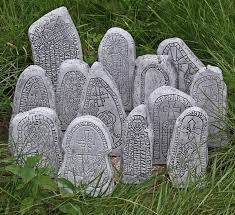
Introduction
While virtually exploring the country of Norway this past year, I came across many topics I found interesting, including their Vikings History, their closeness with nature, and the attachment to Christianity. While researching these topics, I was able to see what connected the three subjects and to the Scandinavian country: Norse Paganism. Although I had always found religion and mythology intriguing, I knew almost nothing about the old Norse Religion. I went on a deep dive into some of the most popular stories. Not only did I become invested in how this religion impacted Norway, but I was also very interested in seeing how it impacted the world around me. This led me to my research question: What is Norse Paganism, and how it affects Norway and the world today?
Norse Paganism, more commonly known as Norse Mythology, is a polytheistic belief system that started in Norway and spread across Scandinavia many centuries ago. In recent years, there has been a resurgence in this belief system, especially in the religious following, festivals, holidays, pop culture, art, and sadly, supremacists groups. It is essential to explore these impacts and learn how Norse Paganism has changed the world we live in.
What is Norse Paganism?
Norse Paganism, also known as Norse Mythology, the Old Way, or Forn Sidr, is a religion that dates back thousands of years and stems from the Scandinavia countries, specifically Norway, Denmark, Iceland, and Sweden. According to Daniel Mccoy, the author of The Viking Spirit: An Introduction To Norse Mythology and Religion, the first traces of Norse paganism can be dated back to around 500 BCE, or the Scandinavian Iron Age (Mccoy, 2016).
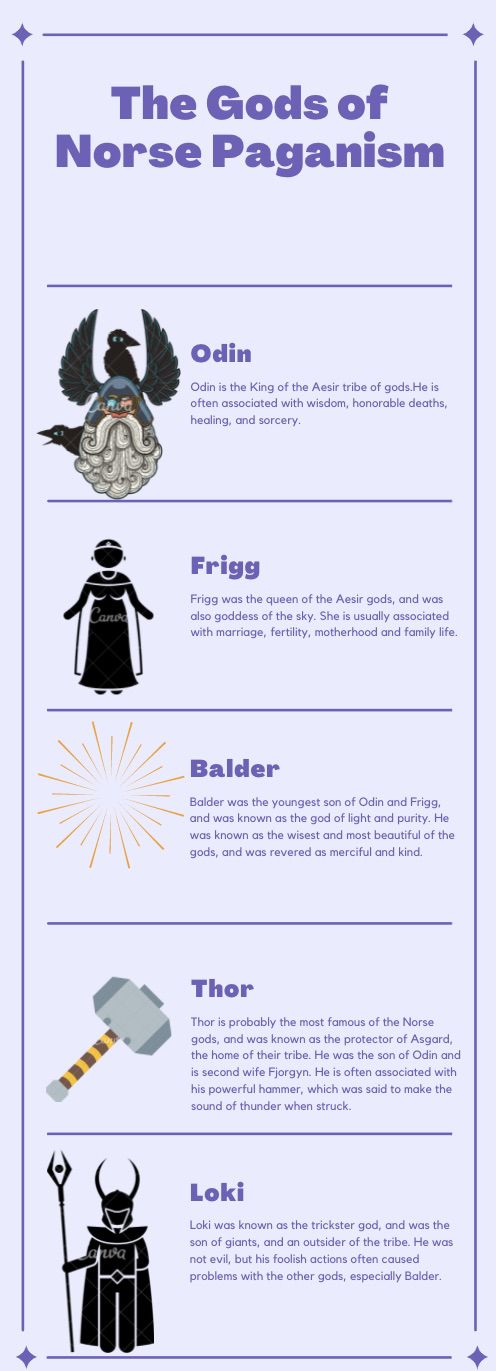
(Lindow 2002)
(Lindow 2002)
The religion was prevalent across the countries during the height of the Viking Age, in 800 AD (DuBois, 1999). According to Mccoy, this was the century when Norwegian Vikings colonized Iceland, further spreading their religion (Mccoy, 2016). But shortly after, around the year 900, the Norwegian Vikings began raiding the British Isles, where they contacted the English Church. As seen in From Viking Stronghold to Christian Kingdom State Formation in Norway by Sverre Bagge (2010), this led to the beginning of Norse Paganism's fall . With this new interaction, Christianity began to spread across Scandinavia. Mccoy (2016), writes that Norway had a significant Christian presence by the beginning of the tenth century. Still, the transition began when the new king, Hákon Aðalsteinsfóstri, was baptized (Mccoy, 2016). Although he never spoke out against paganism, he did begin to set up a new system of religion, especially with the addition of a bishop.
As seen in Bagge's (2010) writing, the succeeding king, Olaf Tryggvason, utilized Christianity and its supporters to conquer Norway by destroying pagan sites and forcing conversions. After his death, a relative of his took the throne and continued his work. According to Stefan Brink, the author of Christianization and the Emergence of the Early Church in Scandinavia, In The Viking World, it is believed that Norway was fully converted by 1022. The rest of the Scandinavian countries completed the shift around 1100, with the last pieces of oral stories being traced to around 1300 (Brink, 2012).
Although it seems that Norse Paganism is a thing of the past, there has been a recent revival of the religion. According to the Scandinavian Academic Society, after a rebirth period in the mid-1900s, there are now over 20,000 people across the world that follow Norse Paganism, which is now known as Odinism, Asatru, or Heathery (Gaustad, 1982).
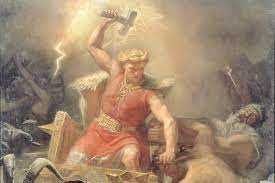
How Is Norse Paganism Impacting Norway Today?

Poster from the Northern Lights Festival (Fjord Tours)
Poster from the Northern Lights Festival (Fjord Tours)
Although the country of Norway has mostly moved on from its pagan roots, there are still some things they practice that have ties to their ancestral beliefs. Every January, according to one Norwegian travel agency, Norway holds Nordlysfestivalen, or The Northern Lights Festival (Fjord Tours, 2020). Although the festival is centered around modern and classical music, its tradition of celebrating the Aurora Borealis and welcoming the sun after a winter of darkness can be traced back to Norse Paganism (History - Nordlysfestivalen).
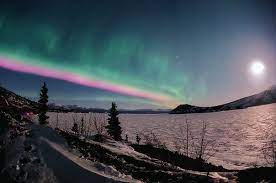
The Northern Lights or The Aurora Borealis (Northern Lights, 2018)
The Northern Lights or The Aurora Borealis (Northern Lights, 2018)
The Northern Lights or the Aurora Borealis have many connections to Norse myths, but the most famous one, according to David Mccoy (2016), is the belief that the lights were the Bifrost. This is the rainbow bridge that connected Midgard, the human world, to Asgard, the home of the gods (Mccoy, 2016). On the other hand, Fjord Tours writes that the lights were believed to reflect the shields the Valkyrie warriors held as they were leading Viking warriors to Valhalla, the Norse equivalent of Heaven (Fjord Tours, 2020). They were celebrated as a symbol of the gods and were very important to the religion. Although we now understand the science behind the lights, the people of Norway still look to them during this festival and celebrate their culture.
In Norse paganism, the divinity of the sun and moon were known as Sol and Mani. As seen in the Poetic Edda, the Norse believed that their gods created the sun and moon cycles as well as the seasons to help Sol and Mani move their symbols across the sky (Larrington, 2019). Although there isn't much information about the worship of these gods, Mccoy (2016) states that there are many rock carvings from across the Viking age depicting their movements . Researchers can deduce that this movement was critical to the pagans, and the celebration of the sun's return after winter can be tied back to that original belief.
How Does Norse Paganism Impact Holidays Across the World?
Since Christianity is a booming religion in Norway, Christmas and the Advent season are very important to their culture. Traditions such as decorating the streets with light and trees, having traditional Scandinavian meals, and covering one's own home with wreaths and garland are prevalent (History TV). But many of these traditions and beliefs stem from elements of their old pagan roots. Some examples of this include the practice of having a Christmas ham, the belief in Santa Claus and his flying reindeer, and mistletoe. According to History.org, the Christmas ham can be traced back to the view that when a Viking warrior died an honorable death, he would be given a feast every night in the afterlife (History TV).
Next, Santa Claus and his flying reindeer are believed to be mainly inspired by Odin, king of the Norse gods, and his flying eight-legged horse, Sleipnir. Odin is also usually portrayed as a chubby older man with a long beard, which sounds familiar to the Christmas legend we all know (Nikel, 2021).
Lastly, although mistletoe has many druid roots, many believe its usage in Christmas is because of the Norse god Balder. In one myth, Balder was killed by an arrow poisoned by mistletoe (Lindow, 2002). While crying for her son's death, Frigga, the queen of the gods, turned the red berries of the mistletoe white with her tears. Since these berries held her love for Balder, he was brought back to life. The mistletoe became a symbol of love for the Norwegian people, which may be why we see them now as a celebration of romance (Nikel, 2021).
Although many of these traditions have crossed borders, some have stayed attached to the Scandinavian parts of the world. One of the most well-known is the Yule Goat or the Julebukk. Since the old pagan holiday, Yule was centered around welcoming in winter, the harvested corn was mended into the shape of a goat and was used to keep away the evil spirits (Mccoy, 2016). As Yule transitioned into Christmas, the Julebukk legend changed as well. After making a goat, it would watch to see if you were behaving and then leave gifts for good children. This legend has changed to incorporate Santa Claus and "Elf on the Shelf," but the making of the Yule Goat is still prominent in the Norwegian culture and is used to decorate their Christmas trees (Nikel, 2021). As you can see, although the country practices a new religion now, they have incorporated parts of their past into an internationally built religious holiday.
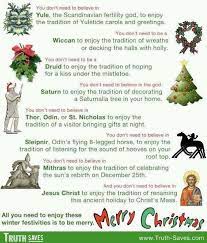
Graphic depicting the different pagan sources of Christian Christmas traditions (Truth Saves)
Graphic depicting the different pagan sources of Christian Christmas traditions (Truth Saves)
As seen in the picture provided, Christmas is directly attached to Christianity in the United States and many countries with similar cultures. While this is understandable, since the word itself comes from "Christ's Mass" following the believed birth of Jesus, it alienates those who do not practice Christianity. It is also quite ignorant to stop people from practicing a holiday that stems from so many cultures and religions just because of one belief system. Overall, it's important to remember that although Christmas is seen as solely a Christian thing in the United States, it is a combination of cultures, including the old Norse religion, that creates the holiday we know and love today.
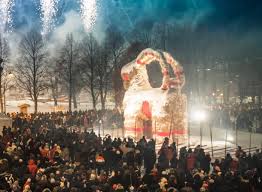
Yule goat (Ancient pages ,2017)
Yule goat (Ancient pages ,2017)
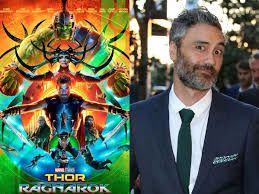
Taika waititi (Web Media, 2018)
Taika waititi (Web Media, 2018)
How Did Norse Paganism Impact Pop Culture?
The image presented here is Taika Waititi, the director of Marvel’s blockbuster movie Thor: Ragnarok. This image comes from a clip where Waititi was discussing the Norse roots in his film. The Marvel movies are top-rated here in the United States, as well as in Norway. But the reception of these movies may be odd, especially for the country where the myths that inspire these films come from (Barnett, 2018). As seen in John Lindow’s "Norse Mythology, a Guide to the Gods, Heroes, Rituals, and Beliefs" (2002), the characters in these movies, Thor, Loki, Odin, are all figures in Norse Mythology. Like the Bifrost, Hel, Asgard, and Johetenheim, places in these films are all places in this old religion (Lindow, 2002). Ragnarok itself was the Scandinavian explanation of the end of the world, similar to the Christian concept of the Four Horsemen of the Apocalypse.
Although this may seem normal to us, since we see these movies as fiction, this may be strange to the small clusters of people in Norway and Scandinavia that still practice this. Even the majority population that sees it as a past part of their culture keeps them separate. Thor in Marvel is a completely different person than Thor from Norse myths (Thompson, 2021).
According to one article in The Independent by David Barnett, these movies are helping spread Norse Mythology and culture. It has inspired an increased interest in the religion and more pop culture exposure for the culture (Barnett, 2018). But it has also led to confusion. According to Barnett, the movies “cleaned” Thor up, made him a hero and made Loki a villain (Barnett, 2018). As described in Barnett’s article and seen in Lindow’s book (2002)2018), the original myths often describe Thor as unintelligent and unhelpful, while Loki is more of a trickster . This simplifies the original tales and beliefs, which isn’t a problem since adaptations are typical. But, this is the only exposure many Americans have to Norse myths.
An article by travel writer Christa Thompson talks about how important it is to understand the legacy behind the characters of Thor while watching these movies. It gives examples of old runic stones, showing the old gods and their infamous weapons like Thor’s hammer and Loki’s Staff (Michell, 1994). Although Norwegians don’t expect all Marvel fans to study up on their runes, understanding how the culture differs from the comics is very important (Thompson, 2021).
There are many other pop culture representations of Norse myths. Some of these are Attack on Titan, Doctor Who, Supernatural, Stargate, Magnus Chase, and How to Train Your Dragon.
How has Norse Paganism Impacted Tattoos Across the World?
Norse mythology and culture have become a global interest, and that has started stemming into artwork, especially tattoos. As seen in a Life in Norway article by David Nikel (2018), the concept started in Norway when those of deep Norse heritage got tattoos of traditional symbols to show their pride. Painting on the skin of Viking warriors and drawing characters on boats and homes were very important to Norse culture, and these symbols still carry meaning in Norway now. But these pieces of culture have spread worldwide, with people covering their skin in everything from Odin’s infamous Ravens and Valkyrie warriors to words of power being written in ancient Norse runes that researchers can trace back to Vikings. When talking about these runic tattoos, Nikel’s (2018) mentioned doing so with care since translations are complex, and these words have meaning to those with deep roots in the culture. According to the artist, the runes in the picture to the right can be translated in many ways but generally mean protection and courage. In continuation, the artwork of Viking ships is trendy online, as seen in this Instagram picture.
According to the tattoo parlor Tattoo Me Now, one of the most common Norse tattoos globally is the Aegishjalmr or the Helm of Awe and Terror (Tattoo Me Now, 2018). In Norse paganism, the Aegishjalmr is one of the most potent magic runes in the universe, as mentioned in John Lindow’s (2002) work. This symbol was often painted on Viking warriors before battle to cause fear in their enemies (Mccoy, 2018). Another top-rated Norse tattoo, according to this parlor, is The Valknut or Odin’s knot (Tattoo Me Now, 2018). The symbol was initially carved into Viking ships and represented the leader of the pagan gods.
As you can see, although these tattoos stem from symbols and art from Norwegian paganism and Viking culture, these have become a worldwide phenomenon and are a perfect example of how Norse culture has spread globally.
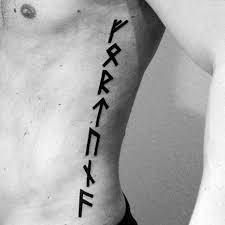
Norse Runes Tattoo (Elly, 2018)
Norse Runes Tattoo (Elly, 2018)
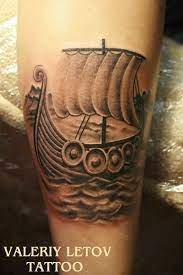
Viking Ship tattoo (Elly, 2018)
Viking Ship tattoo (Elly, 2018)
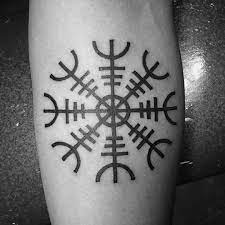
Aegishjalmr or the Helm of Awe and Terror (Elly, 2018)
Aegishjalmr or the Helm of Awe and Terror (Elly, 2018)
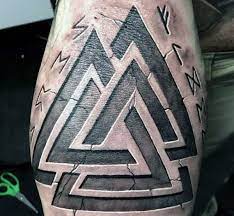
Odin's Knot (Elly, 2018)
Odin's Knot (Elly, 2018)
How are Beards Connected to Norse Paganism?
Although modern media has given us many images of how they believed Norse pagans wore their hair, there isn’t enough anthropological information to make any solid conclusions. One thing we do know, according to the History Collections, is that male Vikings had long beards as a symbol of their manliness and honoring Odin. Men who were unable to grow beards were seen as weak and unfit to be warriors. Many current followers of the religion believe growing a beard is an integral part of the pillars of Heathenism (History Collection, 2017).
A prime example of this is an ArmyTimes article written by J.D. Smikens (2019) . In 2019, one soldier, Sgt. 1st Class Benjamin Hopper, applied for a religious exemption from shaving his beard, stating that a “skegg” or a Norse warrior beard was a symbol of his commitment to the religion and the warrior lifestyle. Smikens (2019) writes that the sergeant sees it as a way to honor his ancestors and the ancient gods, as well as reconnect with his intended course of life while away . This is a perfect example of how religion has changed over time but still has ties to its roots.

How has Norse Paganism Been Perverted by Hate Groups?
While it may seem that the spread of Norse culture and paganism is a great thing, not all of it has been positive. According to Geoff McMaster at the University of Alberta, white supremacists groups, especially Neo-Nazi's are appropriating Norse lore, utilizing it to spread hate and fear in communities (Webber, 2018). Some examples of this are the images of Thor's mighty hammer placed on flags and banners at the hateful Charlottesville rally and in New Zealand when the Christchurch shooter wrote 'See you in Valhalla' in his xenophobic manifesto. In Canada, a Finnish white supremacist group has taken on the name Odin and opened up a new chapter in Alberta. McMaster believes this association stems from when Hitler idealized the Nordic people as being a "pure uncorrupted race," as stated in the 'Germania,' a popular Nazi text written by a roman historian (Webber, 2018). This couldn't be farther from the truth since anthropological and historical evidence shows that the Norse pagans were a very diverse group. The current participants in the religion are very welcoming.
Natalie van Deusen, a Scandinavian studies scholar, has physical proof of this diversity. A decent amount of skeletal remains left from the Norse Viking age, which has DNA evidence that shows a lot of ethnic exchange (Webber, 2018). Since the Vikings traded and fought in many areas of the northern world, many of them were racially diverse. The most common were Inuit, Middle Eastern, and Spanish. According to Clare Downham, a University of Liverpool scholar, the Vikings and Norse pagans accepted other cultures and were adapting to other peoples constantly (Webber, 2018).
Sigal Samuel (2017), a writer for the Atlantic, stated that the high priest of the Norse Heathen's in Iceland was ashamed and horrified by their sacred symbols in the Charlottesville march . He claimed that the racist interpretation of Norse paganism is a complete perversion since their gods are of mixed races, genders, and sexualities. Their international conference, The Frith Forge, brought up many important issues, including the bastardization of their symbols and ways to make the Asatru theology "racist proof." Many groups are attempting to educate people about the Norse Pagan culture to prevent these negative associations (Samuel, 2017). According to Samuel (2017), the most successful of these groups is the Vikings Against Racism in Sweden, attempting to save their iconography from misuse. Overall, the best thing everyone can do to prevent this perversion is to help spread the Norse Pagan culture and inform others about their true beliefs and diversity.
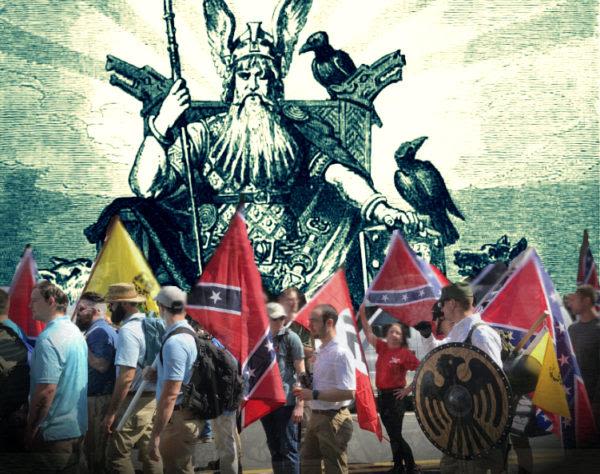
The far-right supremacist groups often utilize paganism as reasons for their actions and include their symbols in their rallys. (Webber, 2018)
The far-right supremacist groups often utilize paganism as reasons for their actions and include their symbols in their rallys. (Webber, 2018)
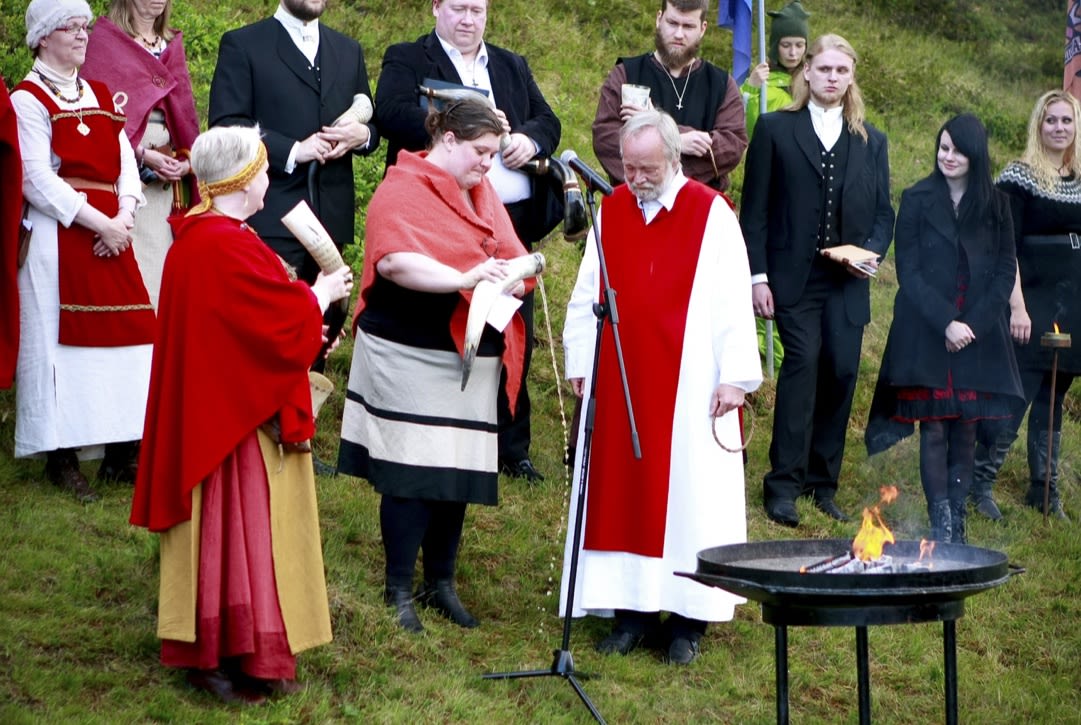
Ásatrú practitioners at a ceremony (Reuters, 2018)
Ásatrú practitioners at a ceremony (Reuters, 2018)
Norse Pagans on Tik Tok fight back against misinformation in their religion.
Norse Pagans on Tik Tok fight back against misinformation in their religion.
As seen above, many Tik Tok influencers are Norse Pagan and speak out against the usage of their symbols and beliefs in hate groups. One of these is @theharpiequeen, also known as Hydie Duke. She is a practicing Norse Pagan from Louisiana who uses her platform to help educate people about the Norse Pagan community. She is working towards creating a safe space for people of color who are new to the community and even has an Etsy shop where she makes religious items for new followers of the religion.
Conclusion
As you can see, Norse Paganism has impacted Norway and the rest of the world a great deal. Inside Norway, there are festivals and Christmas traditions that stem from their pagan roots. Internationally, there are movies and tv shows, tattoos, and facial hair that have been changed because of the spread of the belief system. There have also been negative impacts, with the usage of Norse symbols as motivations for white supremacy and xenophobia. I found all of my research fascinating, but my favorite topic that I plan on delving more into is the meaning behind Norse-inspired tattoos. I found the art very beautiful and yet intriguing. I think this would be the most efficient way to learn more about how Norse Paganism has changed people across the globe. I also hope that more research is done on the impact of Norse Paganism since, as mentioned previously, it is one of the lesser-known mythologies.
Overall, although it's not as known as greek or Roman mythology, Norse mythology has had an enormous impact on all of our lives.
Bibliography
Advanced Ancient Civilization’s Encounter With Primitive People Led To Something Extraordinary – Thought-Provoking Theory Suggests Civilizations “Yule Goat Is A Scandinavian Christmas Tradition Based On Norse Legends And Worship Of God Thor.” Ancient Pages, 11 Dec. 2020, www.ancientpages.com/2017/12/05/yule-goat-scandinavian-christmas-tradition-based-norse-legends-worship-god-thor/.
Bagge, Sverre. From Viking Stronghold to Christian Kingdom State Formation in Norway, c. 900-1350. Copenhagen: Museum Tusculanum Press, 2010. Print.
Barnett, David.“Why Norse Mythology Is Enjoying an Unlikely Renaissance in Popular Culture.” The Independent, Independent Digital News and Media, 19 July 2018, www.independent.co.uk/arts-entertainment/culture-norse-mythology-marvel-comics-film-christianity-neil-gaiman-american-gods-a8444321.html.
Brink, Stefan. 2012. Christianisation and the Emergence of the Early Church in Scandinavia. In The Viking World. Edited by Stefan Brink and Neil Price. p. 621.
Brunet, Paul. “6 Ways to See Northern Lights in the Canadian Arctic.” Arctic Kingdom, Arctic Kingdom, 4 May 2020, arctickingdom.com/6-ways-see-northern-lights-canadian-arctic/.
CiaranRH. “Taika Waititi Talks Thor: Ragnarok.” Webbed Media, 29 May 2019, webbedmedia.com/2018/09/28/taika-waititi-talks-thor-ragnarok/.
DuBois, Thomas A. Nordic Religions in the Viking Age . Philadelphia: University of Pennsylvania Press, 1999. Print.
“Do You Know the Vikings? 6 Myths about the Norse Dispelled.” HistoryCollection.com, 8 July 2017, historycollection.com/know-vikings-6-myths-norse-dispelled/2/#:~:text=Norsemen were expected to grow, they were always well-groomed.
Elly, Ms. “10 Viking Tattoos and Their Meanings.” BaviPower, 21 Apr. 2018, bavipower.com/blogs/bavipower-viking-blog/10-viking-tattoos-and-their-meanings.
Fjord Tours. “Norway's Myths and Folklore around the Northern Lights.” Fjord Tours, 29 June 2020, www.fjordtours.com/inspiration/articles/myths-northern-lights-norway/.
Gaustad, Edwin S. A Documentary History of Religion in America . Grand Rapids: Eerdmans, 1982. Print.
“History - Nordlysfestivalen.” Nordlysfestivalen, www.nordlysfestivalen.no/en/information/history.
“How the Vikings Gave Us Christmas.” Sky HISTORY TV Channel, www.history.co.uk/articles/how-the-vikings-gave-us-christmas.
“Iceland to Build First Temple to Norse Gods since Viking Age.” The Guardian, Guardian News and Media, 2 Feb. 2015, www.theguardian.com/world/2015/feb/02/iceland-temple-norse-gods-1000-years.
Larrington, Carolyne. The Poetic Edda. Oxford Univ. Pr., 2019.
Lindow, John. Norse Mythology a Guide to the Gods, Heroes, Rituals, and Beliefs . Oxford ;: Oxford University Press, 2002. Print.
McCoy, Daniel. The Viking Spirit: an Introduction to Norse Mythology and Religion. CreateSpace Independent Publishing Platform, 2016.
Michell, John. At the Center of the World : Polar Symbolism Discovered in Celtic, Norse, and Other Ritualized Landscapes . New York, N.Y: Thames and Hudson, 1994. Print.
Nikel, David, et al. “Ideas for Viking Tattoos.” Life in Norway, 2018, www.lifeinnorway.net/viking-tattoos/.
Nikel, David, et al. “Christmas Traditions in Norway.” Life in Norway, 29 Jan. 2021, www.lifeinnorway.net/christmas-traditions-in-norway/.
Samuel, Sigal. “What To Do When Racists Try To Hijack Your Religion.” The Atlantic, Atlantic Media Company, 2 Nov. 2017, www.theatlantic.com/international/archive/2017/11/asatru-heathenry-racism/543864/.
“Sol and Mani.” Norse Mythology for Smart People, 6 July 2018, norse-mythology.org/sol-mani/.
Simkins, J.D. “A 'Defining Feature of Masculine Men' - Soldier's Norse Pagan Faith Earns Beard Waiver.” Army Times, Army Times, 30 Dec. 2019, www.armytimes.com/off-duty/military-culture/2019/12/30/a-defining-feature-of-masculine-men-soldiers-norse-pagan-faith-earns-beard-waiver/.
Thefairytaletraveler. “Exploring the Legacy of Thor in Norway - In the Footsteps of Vikings.” The Fairytale Traveler, 4 May 2021, thefairytaletraveler.com/2017/10/04/thor-in-norway/.
“Viking Tattoo Designs, Ideas and Meanings.” Tattoo Me Now, 7 Oct. 2019, www.tattoomenow.com/tattoo-designs/viking-tattoo-designs-ideas-meanings/.
Webber, Shannon. “White Supremacy's Old Gods.” Political Research Associates, www.politicalresearch.org/2018/02/01/white-supremacys-old-gods-the-far-right-and-neopaganism.